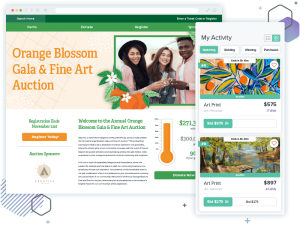As a nonprofit professional, you know the importance of making the donation process as simple as possible. The same principle should be applied to your website! Making the navigation for your organization’s website easy for all your site’s visitors will help your prospective supporters learn more about your nonprofit and make the decision to give easier. Your webpages should be built with Website Accessibility as one of your highest priorities.

Chris Morata, Vice President of Product Development at Qgiv, provides valuable insight into the importance of Website Accessibility and how your website can be made accessible to all your visitors.
What makes a website accessible?
Chris: We could talk all day about this, but I’ll do my best to provide what I think makes a website accessible. A huge part of designing any good experience is having an empathetic mindset. That means being able to put yourself in the shoes of the person interacting with your website, app, whatever it is. The first (and arguably the hardest) part of making a website accessible is not only starting here, but truly making sure it is inclusive of all the users that will take part in that experience, including those with disabilities such as the visual and hearing impaired. That mindset shift is key.
A lot of great guidelines can be found by checking out the Web Accessibility Initiative (WAI). From a design perspective, accessible design requires a well-organized layout with colors that contrast well and text that is easy-to-read. Users with visual impairments such as colorblindness can have trouble seeing the visual organization of elements if the contrast is insufficient or if similar colors are placed next to each other. Additionally, text that does not have enough contrast from the background color will be incredibly difficult to read.
Another crucial aspect of usability is ensuring that the underlying markup of your site can be easily navigated by assistive technologies like screen readers. You can lay a good foundation for this by using semantic HTML for content (<h1>, <h2>, <h3> for top level headings, alt text for images, etc.) and proper markup for forms. Making sure your form fields have corresponding field labels and are correctly grouped are all easy updates to make that will help accessibility.
You also want to make sure you provide a hidden “skip to content” link as the first element on a page. This should only be visible to screen readers and allows a user to bypass repetitive content as they navigate from page to page. This just brushes the surface of what can be done to improve the experience. Again, we could talk all day about this.
Ultimately, I think the answer to the question is that all users, regardless of any disabilities they may or may not have, should have the same experience!
Can you share any tips on what nonprofits can do to improve their website’s accessibility?
Chris: I would definitely start with doing an audit on your current site to make sure it meets the minimum guidelines I mentioned in the first question! These are all fairly trivial to implement and provide a great foundation for having an accessible website.
To test, I would recommend navigating your website while using JAWS (Window) or VoiceOver (Mac) so that you can see and understand firsthand this experience – it can be truly humbling! There are also a TON of great tools that can be found online for testing accessibility, my favorite being tota11y, which works directly in your browser and can do an analysis and provide recommendations for pages when enabled. I would also check out The A11Y Project, a community-driven effort to make the web more accessible. They provide a lot of great how-to guides and even more tools and resources you can utilize!
With seniors becoming more tech-savvy, how can nonprofits make their websites senior friendly?
Chris: Great question! I think a lot of the things I might apply to a website to be more senior friendly are honestly just good practices for any user regardless of age. You can never go wrong with keeping things simple. I am a huge proponent of the KISS (Keep It Short and Simple) principle when it comes to design.
When examining the interface for your site, consider if there are any opportunities to simplify the options available to the user – fewer navigation options, asking fewer questions on a form, etc. I think websites that have a large navigation that go several levels deep can sometimes be hard to navigate. Reducing the number of decisions a user has to make will create less friction and will always contribute to a better experience.
Okay, last question. Why is having a highly accessible website so important?
Chris: Access to the web has become such an important part of society, whether you’re looking for directions from point A to point B, searching for where you should eat dinner tonight, purchasing that jacket you absolutely had to have, or applying for a job. It’s imperative that we are able to provide equal access and opportunity for those with disabilities. The web was built on the premise that it is an open and accessible experience for everyone. Let’s keep it that way.



